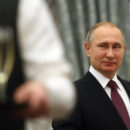by Alan Yu
Energy demand in Asia will continue to climb in the coming decades, which will have critical economic, climate, and geostrategic implications for the United States. Over the next 20 years, India and Southeast Asia are expected to record the world’s highest carbon dioxide growth rates. For this reason, tackling energy-related emissions in this region must be a part of any meaningful global strategy to curb climate change. Accelerating a clean energy transition in Asia is a critical imperative to both help meet booming energy demand and mitigate against climate change. Unfortunately, the Trump administration’s response to these important developments has been shortsighted and mercantile. But a new U.S. Indo-Pacific energy initiative offers a chance for the United States to course correct.
This column outlines the Trump administration’s fossil fuel-focused approach to energy in Asia, points to the clean energy transformation underway in the region, and offers recommendations on how the United States can reposition Asia Enhancing Development and Growth through Energy (Asia EDGE)—the administration’s energy initiative for Asia—in a way that would enable the United States and its companies to drive the clean energy transition in the region, help curb climate change, and sell U.S. energy goods and services.
Trump’s shortsighted and troubling global energy strategy
When it comes to a U.S. global energy strategy, Trump officials have demonstrated a myopic focus on leveraging expanding domestic fossil fuel production to two ends: (1) as a means to export their way to reduced trade deficits; and (2) as a tool for geopolitical competition with U.S. adversaries. Secretary of State Mike Pompeo made both points clear in recent remarks. First, he announced Asia EDGE as the energy pillar of the administration’s Indo-Pacific engagement strategy last July and emphasized its potential to spur U.S. fossil fuel trade. And in March of this year, he outlined his vision of energy in U.S. diplomacy without mentioning the challenge of climate change, even while energy-related emissions in Asia are climbing. President Donald Trump walked away from the Paris climate pledge in part because he claimed other countries were not doing their part. With Asia EDGE, Pompeo missed an opportunity to position the initiative to drive a regional clean energy transition and curb greenhouse gas emissions growth, all led by U.S. clean energy technology. Clearly, the Trump approach to energy in Asia is narrow and mercantile.
In contrast, last December, Congress—recognizing the U.S. economic and geostrategic interest in pursuing a comprehensive energy strategy in the region—passed into law the Asia Reassurance Initiative Act, with broad bipartisan support. The act calls for U.S. companies and national laboratories to partner with countries in Asia to develop national power strategies with an appropriate mix of energy solutions, and it authorizes up to $1 million annually for U.S. programs to advance that objective. The $1 million is a useful starting point, but the Asia energy challenge requires an even more robust approach.
The circumstances in Asia merit a more forward-looking, alternative ambition than the Trump administration approach, and Asia EDGE can and should reflect a 21st century clean energy vision. Countries such as India not only acknowledge the scientific reality and risks of climate change, but have also made major commitments to deploy clean energy solutions—from solar power to electric buses. The irony is that when it comes to U.S. exports and jobs, the Trump administration neglects to champion American clean energy technology, which is globally competitive and a high-value sector. U.S. companies are world leaders in smart grid equipment, battery storage, power sector management services, renewable energy integration software, microgrids, and more.
Focusing on clean energy technology trade would present a higher value chain opportunity for U.S. business; help the United States make up ground on its climate change responsibilities; and offer a compelling economic, environmental, and energy security proposition for foreign counterparts.
The clean energy opportunity in South and Southeast Asia
The United States should prioritize its clean energy engagement in South and Southeast Asia, which together comprise one-third of the world’s population and top the list for projected global energy demand growth over the next 20 years. While fossil fuels, particularly coal, currently play a dominant role in this region, clean energy national policies, resource use, and technology integration are all accelerating—and in surprising ways.
India
In 2015, driven by both the imperative to combat India’s notorious air pollution and a desire to diversify energy sources, Prime Minister Narendra Modi announced—to widespread skepticism—that coal-abundant India would add 175 gigawatts of renewable energy nationwide in just seven years. Fast forward to 2018, and India declared that it was on track to surpass that target. While observers differ on whether the country can ultimately hit this goal, they agree that India has sparked an energy sector transition from a cold start. India, the world’s largest democracy, now presents the leading growth market for future energy opportunities and is flashing clear and bold directional signals for all who wish to follow.
Southeast Asia
With a projected annual growth rate of more than 5 percent, Southeast Asia is predicted to overtake the European Union and Japan to become the world’s fourth-largest economyby 2050. China, through its Belt and Road Initiative, is investing heavily in this priority market, in both the fossil and clean energy sectors. For their part, those in the region seeking to accelerate clean energy transitions vocalize their desire for U.S. investment, equipment, and financing to balance against the risk of overreliance on substandard Chinese equipment and technology.
Setting a new direction
Asia EDGE can be the vehicle to right President Trump’s misguided approach to energy cooperation and climate in the world’s most consequential region. Around the region, governments are writing policies and regulations to spur renewables deployment; renewable energy costs are falling; and investment in clean energy is climbing—all signals that the United States should be aligning its energy approach to the region’s economic and technological future. LNG may be the immediate-term export opportunity, but the United States should make the higher-value, longer-term bet to partner with those in the region who are pivoting to a cleaner energy economy.
Moreover, in the absence of U.S. climate policy leadership, Asia EDGE offers a vehicle for the United States and its companies to support local efforts to make commercial decisions that accelerate progress in the shared responsibility to combat climate change.
At last July’s Asia EDGE launch, the administration cobbled together disparate, small pots of moneys to add to some existing regional energy programs. But now agencies have fiscal year 2019 budgets to work with, and Congress is evaluating FY 2020 budget priorities. These are important months for both to make the right decisions on the strategic direction and resources for Asia EDGE. With this in mind, here are some recommendations for Asia EDGE program direction:
- Washington agencies and U.S. embassies should position clean energy at the top of their Asia EDGE strategies. To do so, they need a deeper bench—particularly since foreign and civil service staff departures under Trump have put agencies further in the hole. Agencies should boost staffing in two categories: (1) clean energy staff in Asia-focused offices in Washington; and (2) American and local staff dedicated solely to clean energy portfolios to serve in U.S. embassies’ economic, development, commercial, and trade finance sections.
- The administration should create and/or bolster multiagency clean energy initiatives with key countries. Power Africa and the S.-India Strategic Energy Partnership, though heavily weighted toward fossil fuels cooperation, could nevertheless serve as models for cleaner, higher-tech programs in partnership with Indonesia, Vietnam, Thailand, and Pakistan—all important counterparts for commercial, strategic, and climate purposes.
- U.S. commercial agencies should leverage the regional buzz over Asia EDGE and the upcoming launch of the new U.S. International Development Finance Corporation to prioritize public clean energy industry promotion events—including (1) multicountry initiatives through which U.S. companies can network at once with multiple counterparts or consortia; and (2) a resumption of clean energy trade missions.
- U.S. diplomatic and development agencies should broaden capacity-building initiatives—traditionally aimed at policymakers and regulators. By expanding such programs to include financiers, commercial partners, and civil society members, agencies could help create conditions for increased clean energy market development.
Conclusion
Asia EDGE presents an opportunity to reset critical, long-standing U.S. commercial, climate, and geostrategic influence in the region. The administration and Congress have a responsibility to launch it with proper strategic direction and strong resourcing. A clean energy focus is the correct path forward.
Originally appeared in AmericanProgress.org



 (909) 335-8100 ·
(909) 335-8100 ·  (909) 335-6777
(909) 335-6777 Email:
Email: